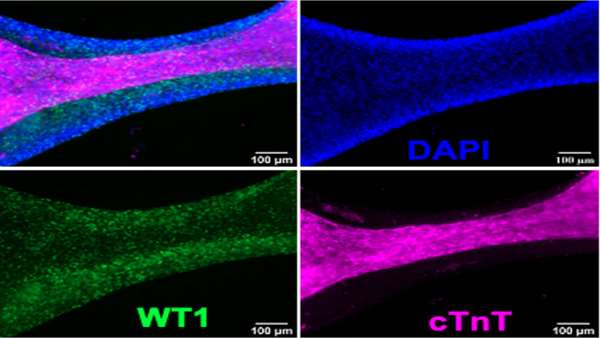Researchers generate protective embryonic heart cells
In their study, published in Nature Communications, these pre-epicardial cells were able to develop into the epicardial cells that form the epicardium, the protective membrane that covers the outer surface of the heart and plays a major role in protecting embryonic heart development.
In their study, published in Nature Communications, these pre-epicardial cells were able to develop into the epicardial cells that form the epicardium, the protective membrane that covers the outer surface of the heart and plays a major role in protecting embryonic heart development. This development, which utilized human-induced pluripotent stem cells, is a step toward the goal of using patients’ cells to generate functioning heart tissue that could be transplanted, similar to donor organs, for the treatment of heart failure.
Ott, a thoracic surgeon at MGH and an associate professor in surgery at Harvard Medical School, and his colleagues developed a recipe to generate pre-epicardial cells from human-induced pluripotent stem cells, which are embryo-like cells derived from reprogrammed mature cells, such as a patient’s skin cells.
When placed in contact with heart muscle cells (or cardiomyocytes), the pre-epicardial cells developed further to become epicardial cells. As the epicardium, these cells drive embryonic heart formation, for example by enhancing the maturation of nearby cardiomyocytes.
Ott notes that scientists are able to retrace early stages of heart development and generate millions of cardiomyocytes from a single blood draw but forming the structure of the heart is more complex. “It has been difficult to retrace later stages of tissue development due to the many cell types involved and the complexity of the three-dimensional environment of the developing heart,” he explains. “Our study introduces a cell type that is much closer to later stages of human cardiac development than what we have been able to generate so far.”
Producing cells that play key roles in forming the structure of the heart is necessary for regenerative medical strategies that may be used in treating heart disease. “While there are many more steps still required to complete the puzzle of heart development, this work adds an important piece that will hopefully help us and others in recapitulating cardiac development to generate novel therapies for heart failure,” says Ott. He envisions that such cell- or tissue-based therapies will provide “on demand” treatments to restore or replace lost organ function in patients suffering from chronic organ failure such as heart failure, end stage lung disease, and kidney disease.
Co-authors include Jun Jie Tan, Jacques P. Guyette, Kenji Miki, Ling Xiao, Gurbani Kaur, Tong Wu, Liye Zhu, Katrina J Hansen, King-Hwa Ling, and David J. Milan.
Funding for the study was provided by the Harvard Stem Cell Institute and the Charles and Sara Fabrikant MGH Research Scholarship.




ارسال به دوستان